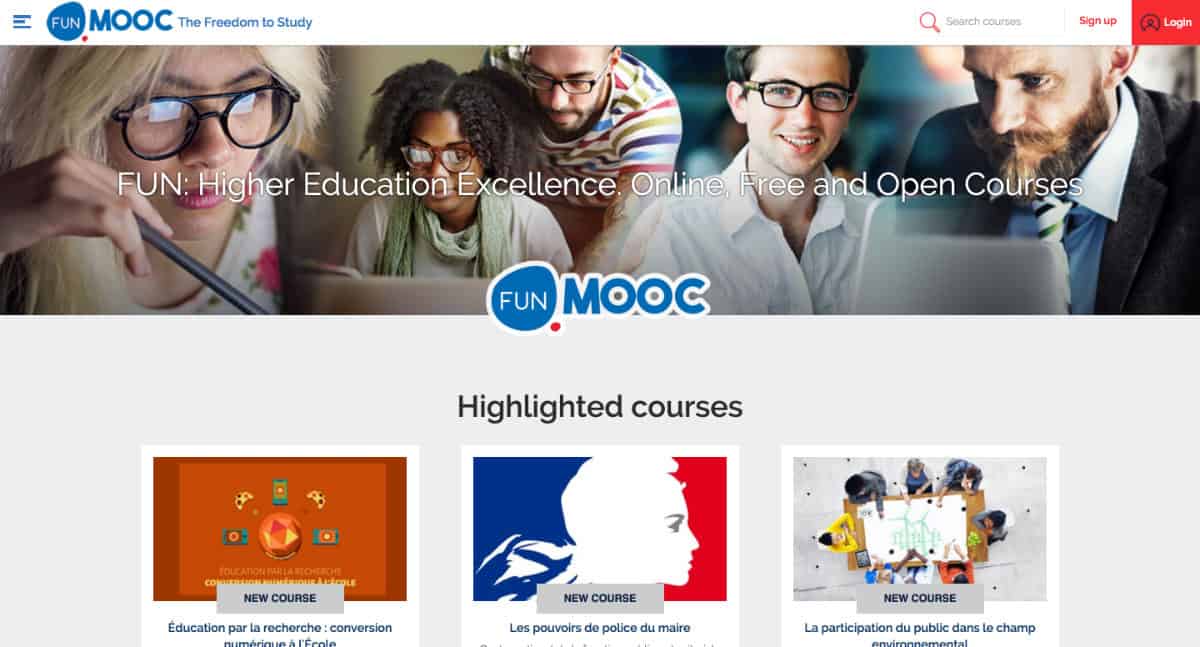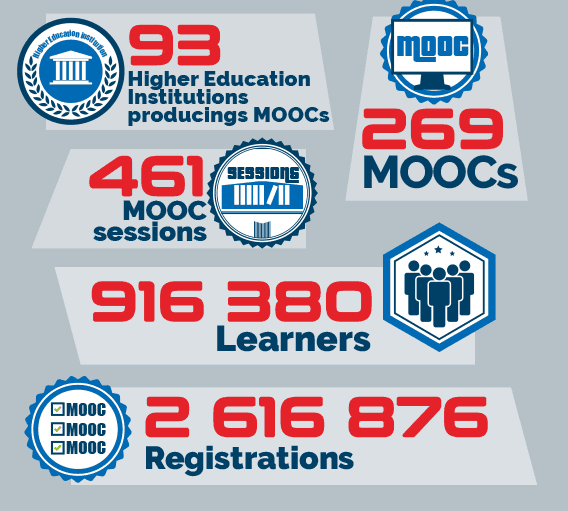France Université Numérique: Meet the MOOC Platform Funded by the French Government
France Université Numérique platform aims to make waves in the Francophone world.
In the past few months, Class Central has been taking a look at a number of regional MOOC providers: XuetangX, EduOpen, and MéxicoX. This time we take an in-depth look at France Université Numérique (FUN) — France’s official MOOC platform.
We interviewed Sandrine Delacroix-Morvan, communication manger at FUN.
When was FUN launched? Why was it created and who is funding it?
The French Ministry of Higher Education launched the project called “France Université Numérique” in July 2013. The aim of this national project is to support French universities in developing online education, and to promote innovative teaching and learning methods using digital and online tools.
One major project in this agenda was the development of the FUN MOOC platform, which was launched in October 2013 and is dedicated to French and Francophone universities and their international academic partners.
Since September 2015, a public organization (called GIP FUN-MOOC) has been created to carry on the FUN platform. The objectives of this organization are to manage the platform and its evolutions, to develop new partnerships and activities in the context of lifelong learning education, and to increase its international visibility — especially in the Francophone world.
The organization currently employs fifteen people and our offices are located in Paris (14th arrondissement).
How many university partners does FUN have? Are any of them international?
FUN has 93 partners among higher education institutions that create MOOCs, including three universities in Belgium, one in Switzerland, and two in Tunisia.
How many courses are being offered? Who usually decides which course to offer? Is there any focus on certain subject/topic areas?
FUN broadcasts 269 MOOCs in 461 MOOCs sessions (figures for January 2017). Each university member of the FUN organization is responsible for its editorial policy and chooses MOOC topics according to this policy. As for the partner institutions, their proposals are submitted to the editorial committee, which decides whether they are allowed to join FUN or not. Subjects are very diverse and reflect the diversity of disciplines in higher education: 15% of the MOOCs are on digital subjects, 10% are in the field of health, and 10% are on sustainable development.
What is the completion rate?
Completion rate varies greatly from one course to another. MOOCs have completion rates comprised between 10 and 25%. Highly specialized and highly professional courses have higher completion rates.
Which are the most popular courses for FUN? (A top 5/10 list with enrollment numbers would be great to have.)
| Higher education institution | MOOC title | Registration numbers |
| Le Cnam | Du manager agile au leader designer | 113357 |
| Université libre de Bruxelles (ULB) | L’anglais pour tous – Spice up Your English | 99693 |
| L’Alliance française de Paris | Cours de français langue étrangère A2 | 82067 |
| Université Paris-Sud | Introduction à la statistique avec R | 47803 |
| Institut Mines-Télécom | Principes des réseaux de données | 37676 |
| Institut Mines-Télécom | Fondamentaux pour le Big Data | 36562 |
| Inria | Python : des fondamentaux à l’utilisation du langage | 33268 |
| Le Cnam | Le droit des contrats de travail en France | 31194 |
| Groupe INSA | Introduction à HTML5 – Animations et jeux | 29319 |
| Institut Mines-Télécom | Innover et entreprendre dans un monde numérique | 25380 |
How many users does FUN have? What percentage of the user base is outside of France? Which countries are most popular?
We have 916,380 users in 224 countries: 48% of users are in France, and 52% are outside of France (figures for January 2017); of the latter, most users come from Brazil and Morocco.
For many MOOC platforms, most users already have a degree. Is it true for FUN too?
Users of our platform are predominantly graduates:
- Other: 4%
- Nothing: 1%
- General: Certificate of Secondary Education: 2%
- High School Diploma: 10%
- DUT & BTS (two types of professional training in two years): 11%
- Bachelor: 19%
- Master and/or Engineering degree: 41%
- PhD: 8%
- Not documented: 4%
What is the other demographic information about FUN users — age and gender?
The learners’ profiles are quite similar to most international platforms: 64% are in the 25–50 -year-s old age group, and 47% hold a Master’s degree.
Forty-six percent of the learners are female.
See below for a more specific breakdown of the data.
Gender:
- Women: 46%
- Men: 50%
- Not documented: 4%
Age:
- 18 to 25 years old: 7%
- 25 to 35 years old: 21%
- 35 to 50 years old: 32%
- 50 to 65 years old: 26%
- Under 18 years old: 1%
- Not documented: 6%
- Over 65 years old: 8%
I understand that FUN is built upon Open edX. Have any modifications be done specially for the purpose of FUN?
Indeed, we have made modifications to the platform. We have developed an additional layer that makes the following changes:
- A custom ++ theme (i.e. listing and featuring courses).
- Managing users and courses: FUN back office.
- Certification the “FUN way.”
- A custom video infrastructure.
- Analytics 101, or fun-dashboards: only the basics for now!
- Additional xblocks.
Can you get a certificate or earn credits for taking courses on FUN? If you can receive credits, are these credits transferable between universities?
Since Spring 2016, FUN has deployed a monitored online proctoring system. Through this system, higher education institutions can issue verified certificates. Some of them further deliver European Credits Transfer System (ECTS) to the learners who got a verified certificate, and therefore recognize the MOOC as part of a curriculum.
How does FUN monetize? Does it have any further plans on monetization?
The only monetization on the MOOC platform is the payment for certification: a learner can still register, follow a MOOC and get an honor-code certificate for free. However, new services are being provided (dedicated SPOC and white-label platforms) for higher education institutions to develop lifelong learning and continuous training, and therefore build a sustainable business model.
How does FUN envision the role of MOOCs in traditional education in the future?
By associating MOOCs with face-to-face classes on campus and using MOOCs in the flipped classroom style, the effectiveness of learning would be improved.
What are some of the biggest challenges faced by FUN? I.e. cultural, political, technical, and so on.
- Bringing the world of universities closer to that of companies, to facilitate lifelong learning.
- Facilitating changes in educational practices in universities.
What are the plans specifically for FUN in 2017?
We have several white-label platform projects for 2017. The most important one is the MOOC platform for the Moroccan universities. This platform will allow these universities to propose MOOCs that are dedicated to their students, and develop digital teaching and learning in the context of over-crowded campuses.
We work with several French Edtech startups on an R&D project. The objective is to enrich the user experience on FUN with new functionalities:
- broadcasts of enriched videos (quizzes, bubbles, links);
- use of Memorial Anchor to increase engagement rate and facilitate skill acquisition;
- development of “MOOC live” to allow multi-participant real-time interactions; and
- improve accessibility.
We know that more and more learners meet in different locations (FabLab, media libraries, public places, and so on) to exchange/cooperate around the MOOC. We plan to develop a quality label for such places.








